Assessing the Effects of Delivery Attributes on E-Shopping Consumer Behaviour
Abstract
:1. Introduction
2. Literature Review and Hypotheses Development
3. Research Approach
3.1. Data
3.2. Data Analysis
4. Results
4.1. Data Description
4.2. Significance of the Effects of Delivery Attributes on E-consumption Behaviour
4.3. Pattern Recognition
4.3.1. Importance of Delivery Time
4.3.2. Importance of Delivery Fee
4.3.3. Importance of Delivery Reception
4.3.4. Influence of Delivery Fee
4.3.5. Influence of Delivery Reception
5. Discussion
6. Conclusions
Author Contributions
Funding
Institutional Review Board Statement
Informed Consent Statement
Data Availability Statement
Acknowledgments
Conflicts of Interest
References
- Statista. E-Commerce Worldwide. 2021. Available online: https://www.statista.com/topics/871/online-shopping/#dossier-chapter2 (accessed on 12 December 2021).
- Morganti, E.; Seidel, S.; Blanquart, C.; Dablanc, L.; Lenz, B. The Impact of E-Commerce on Final Deliveries: Alternative Parcel Delivery Services in France and Germany. Transp. Res. Procedia 2014, 4, 178–190. [Google Scholar] [CrossRef] [Green Version]
- Cárdenas, I.; Beckers, J.; Vanelslander, T. E-Commerce Last-Mile in Belgium: Developing an External Cost Delivery Index. Sustain. Effic. Manag. Issues Urban Goods Transp. New Trends Appl. 2017, 24, 123–129. [Google Scholar] [CrossRef]
- Lin, Y.H.; Wang, Y.; He, D.; Lee, L.H. Last-Mile Delivery: Optimal Locker Location under Multinomial Logit Choice Model. Transp. Res. Part E Logist. Transp. Rev. 2020, 142, 102059. [Google Scholar] [CrossRef]
- Nogueira, G.P.M.; de Assis Rangel, J.J.; Shimoda, E. Sustainable Last-Mile Distribution in B2C e-Commerce: Do Consumers Really Care? Clean. Responsible Consum. 2021, 3, 100021. [Google Scholar] [CrossRef]
- de Oliveira, L.K.; Morganti, E.; Dablanc, L.; de Oliveira, R.L.M. Analysis of the Potential Demand of Automated Delivery Stations for E-Commerce Deliveries in Belo Horizonte, Brazil. Res. Transp. Econ. 2017, 65, 34–43. [Google Scholar] [CrossRef] [Green Version]
- Buldeo Rai, H.; Verlinde, S.; Macharis, C. The “next Day, Free Delivery” Myth Unravelled. Int. J. Retail Distrib. Manag. 2019, 47, 39–54. [Google Scholar] [CrossRef]
- Nguyen, D.N.; Leeuw, S.; Dullaert, W.; Foubert, B.P.F. What Is the Right Delivery Option for You? Consumer Preferences for Delivery Attributes in Online Retailing. J. Bus. Logist. 2019, 40, 299–321. [Google Scholar] [CrossRef] [Green Version]
- Ignat, B.; Chankov, S. Do E-Commerce Customers Change Their Preferred Last-Mile Delivery Based on Its Sustainability Impact? Int. J. Logist. Manag. 2020, 31, 521–548. [Google Scholar] [CrossRef]
- Xiao, Z.; Wang, J.J.; Liu, Q. The Impacts of Final Delivery Solutions on E-Shopping Usage Behaviour. Int. J. Retail Distrib. Manag. 2018, 46, 2–20. [Google Scholar] [CrossRef]
- Holguín-Veras, J.; Amaya Leal, J.; Seruya, B.B. Urban Freight Policymaking: The Role of Qualitative and Quantitative Research. Transp. Policy 2017, 56, 75–85. [Google Scholar] [CrossRef]
- Marino, G.; Zotteri, G.; Montagna, F. Consumer Sensitivity to Delivery Lead Time: A Furniture Retail Case. Int. J. Phys. Distrib. Logist. Manag. 2018, 48, 610–629. [Google Scholar] [CrossRef]
- Prebreza, A.; Shala, B. The Trust in Online Shopping during COVID-19: Case Study from Kosovo. Open Access Libr. J. 2021, 8, e7288. [Google Scholar] [CrossRef]
- Vasić, N.; Kilibarda, M.; Kaurin, T. The Influence of Online Shopping Determinants on Customer Satisfaction in the Serbian Market. J. Theor. Appl. Electron. Commer. Res. 2019, 14, 70–89. [Google Scholar] [CrossRef] [Green Version]
- Chincholkar, S.; Sonwaney, V. Website Attributes and Its Impact on Online Consumer Buying Behaviour: An Empirical Study of Online Consumers in Mumbai Region. Indian J. Sci. Technol. 2017, 10, 1–9. [Google Scholar] [CrossRef] [Green Version]
- Lim, H.; Dubinsky, A.J. Consumers’ Perceptions of E-shopping Characteristics: An Expectancy-value Approach. J. Serv. Mark. 2004, 18, 500–513. [Google Scholar] [CrossRef] [Green Version]
- Amorim, P.; DeHoratius, N.; Eng-Larsson, F.; Martins, S. Customer Preferences for Delivery Service Attributes in Attended Home Delivery. Chic. Booth Res. Pap. 2020. [Google Scholar] [CrossRef]
- Oliveira, L.K.; Oliveira, R.L.M.; Sousa, L.T.M.; Caliari, I.P.; Nascimento, C.O.L. Analysis of Accessibility from Collection and Delivery Points: Towards the Sustainability of the e-Commerce Delivery. Urbe Rev. Bras. Gest. 2019, 11, e20190048. [Google Scholar] [CrossRef] [Green Version]
- Buldeo Rai, H.; Broekaert, C.; Verlinde, S.; Macharis, C. Sharing Is Caring: How Non-Financial Incentives Drive Sustainable e-Commerce Delivery. Transp. Res. Part Transp. Environ. 2021, 93, 102794. [Google Scholar] [CrossRef]
- Iannaccone, G.; Marcucci, E.; Gatta, V. What Young E-Consumers Want? Forecasting Parcel Lockers Choice in Rome. Logistics 2021, 5, 57. [Google Scholar] [CrossRef]
- Caspersen, E.; Navrud, S. The Sharing Economy and Consumer Preferences for Environmentally Sustainable Last Mile Deliveries. Transp. Res. Part Transp. Environ. 2021, 95, 102863. [Google Scholar] [CrossRef]
- Marcucci, E.; Gatta, V.; Le Pira, M.; Chao, T.; Li, S. Bricks or Clicks? Consumer Channel Choice and Its Transport and Environmental Implications for the Grocery Market in Norway. Cities 2021, 110, 103046. [Google Scholar] [CrossRef]
- Buldeo Rai, H.; Verlinde, S.; Macharis, C. Who Is Interested in a Crowdsourced Last Mile? A Segmentation of Attitudinal Profiles. Travel Behav. Soc. 2021, 22, 22–31. [Google Scholar] [CrossRef]
- Janjevic, M.; Winkenbach, M. Characterizing Urban Last-Mile Distribution Strategies in Mature and Emerging e-Commerce Markets. Transp. Res. Part Policy Pract. 2020, 133, 164–196. [Google Scholar] [CrossRef]
- Ebit; Nielsen Webshoppers. 2021. Available online: https://www.ebit.com.br/ (accessed on 12 December 2021).
- Yuen, K.F.; Wang, X.; Ng, L.T.W.; Wong, Y.D. An Investigation of Customers’ Intention to Use Self-Collection Services for Last-Mile Delivery. Transp. Policy 2018, 66, 1–8. [Google Scholar] [CrossRef]
- Liu, H.; Huang, Y.; Wang, Z.; Liu, K.; Hu, X.; Wang, W. Personality or Value: A Comparative Study of Psychographic Segmentation Based on an Online Review Enhanced Recommender System. Appl. Sci. 2019, 9, 1992. [Google Scholar] [CrossRef] [Green Version]
- Hagen, T.; Scheel-Kopeinig, S. Would Customers Be Willing to Use an Alternative (Chargeable) Delivery Concept for the Last Mile? Urban Transp. Plan. Policy Chang. World Bridg. Gap Theory Pract. 2021, 39, 100626. [Google Scholar] [CrossRef]
- Liu, C.; Wang, Q.; Susilo, Y.O. Assessing the Impacts of Collection-Delivery Points to Individual’s Activity-Travel Patterns: A Greener Last Mile Alternative? Transp. Res. Part E Logist. Transp. Rev. 2019, 121, 84–99. [Google Scholar] [CrossRef]
- Song, Z. The Geography of Online Shopping in China and Its Key Drivers. Environ. Plan. B Urban Anal. City Sci. 2021, 23998083211002188. [Google Scholar] [CrossRef]
- Irawan, M.Z.; Wirza, E. Understanding the Effect of Online Shopping Behavior on Shopping Travel Demand through Structural Equation Modeling. J. East. Asia Soc. Transp. Stud. 2015, 11, 614–625. [Google Scholar] [CrossRef]
- Lim, H.; Widdows, R.; Hooker, N.H. Web Content Analysis of E-grocery Retailers: A Longitudinal Study. Int. J. Retail Distrib. Manag. 2009, 37, 839–851. [Google Scholar] [CrossRef]
- Cherrett, T.; Dickinson, J.; McLeod, F.; Sit, J.; Bailey, G.; Whittle, G. Logistics Impacts of Student Online Shopping—Evaluating Delivery Consolidation to Halls of Residence. Transp. Res. Part C Emerg. Technol. 2017, 78, 111–128. [Google Scholar] [CrossRef] [Green Version]
- Mehmood, S.M.; Najmi, A. Understanding the Impact of Service Convenience on Customer Satisfaction in Home Delivery: Evidence from Pakistan. Int. J. Electron. Cust. Relatsh. Manag. 2017, 11, 23–43. [Google Scholar] [CrossRef]
- Cortina, J.M. What Is Coefficient Alpha? An Examination of Theory and Applications. J. Appl. Psychol. 1993, 78, 98–104. [Google Scholar] [CrossRef]
- Gliem, J.A.; Gliem, R.R. Calculating, Interpreting, and Reporting Cronbach’s Alpha Reliability Coefficient for Likert-Type Scales. In Proceedings of the 2003 Midwest Research to Practice Conference in Adult, Continuing, and Community Education, Columbus, OH, USA, 8–10 October 2003; pp. 82–88. [Google Scholar]
- Taber, K.S. The Use of Cronbach’s Alpha When Developing and Reporting Research Instruments in Science Education. Res. Sci. Educ. 2018, 48, 1273–1296. [Google Scholar] [CrossRef]
- Visa, S.; Ramsay, B.; Ralescu, A.; VanDerKnaap, E. Confusion Matrix-Based Feature Selection. In Proceedings of the 22nd Midwest Artificial Intelligence and Cognitive Science Conference, Cincinnati, OH, USA, 16–17 April 2011; pp. 121–127. [Google Scholar]
- Washington, S.P.; Karlaftis, M.G.; Mannering, F. Statistical and Econometric Methods for Transportation Data Analysis; Chapman and Hall/CRC: Boca Raton, FL, USA, 2003. [Google Scholar]
- Schmidhuber, J. Deep Learning in Neural Networks: An Overview. Neural Netw. 2015, 61, 85–117. [Google Scholar] [CrossRef] [Green Version]
- Pedregosa, F.; Varoquaux, G.; Gramfort, A.; Michel, V.; Thirion, B.; Grisel, O.; Blondel, M.; Prettenhofer, P.; Weiss, R.; Dubourg, V.; et al. Scikit-Learn: Machine Learning in Python. J. Mach. Learn. Res. 2011, 12, 2825–2830. [Google Scholar]
- Aschwanden, G.D.; Wijnands, J.S.; Thompson, J.; Nice, K.A.; Zhao, H.; Stevenson, M. Learning to Walk: Modeling Transportation Mode Choice Distribution through Neural Networks. Environ. Plan. B Urban Anal. City Sci. 2021, 48, 186–199. [Google Scholar] [CrossRef]
- Friedman, J.H. Greedy Function Approximation: A Gradient Boosting Machine. Ann. Stat. 2001, 29, 1189–1232. [Google Scholar] [CrossRef]
- Zhao, Q.; Hastie, T. Causal Interpretations of Black-Box Models. J. Bus. Econ. Stat. 2021, 39, 272–281. [Google Scholar] [CrossRef]
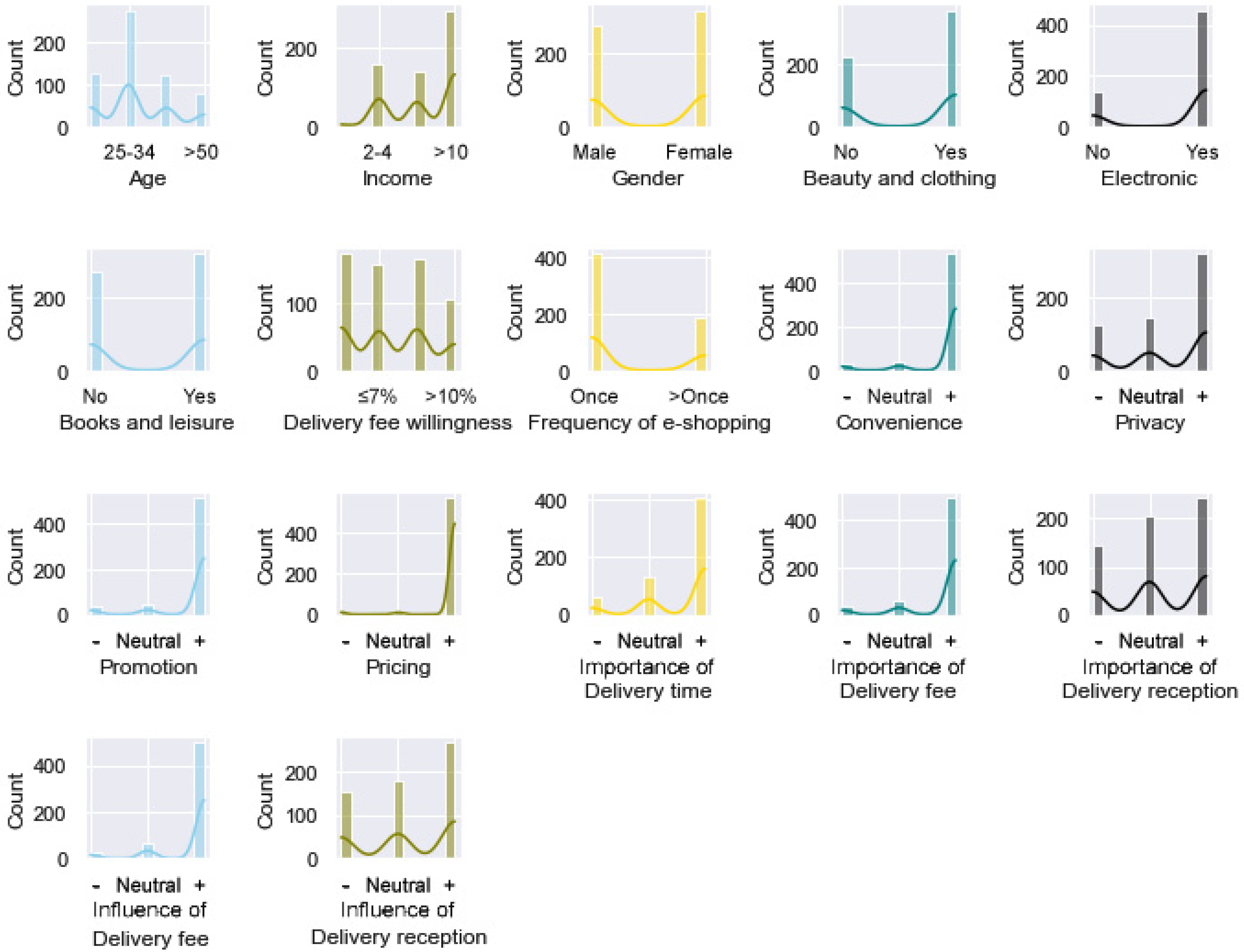
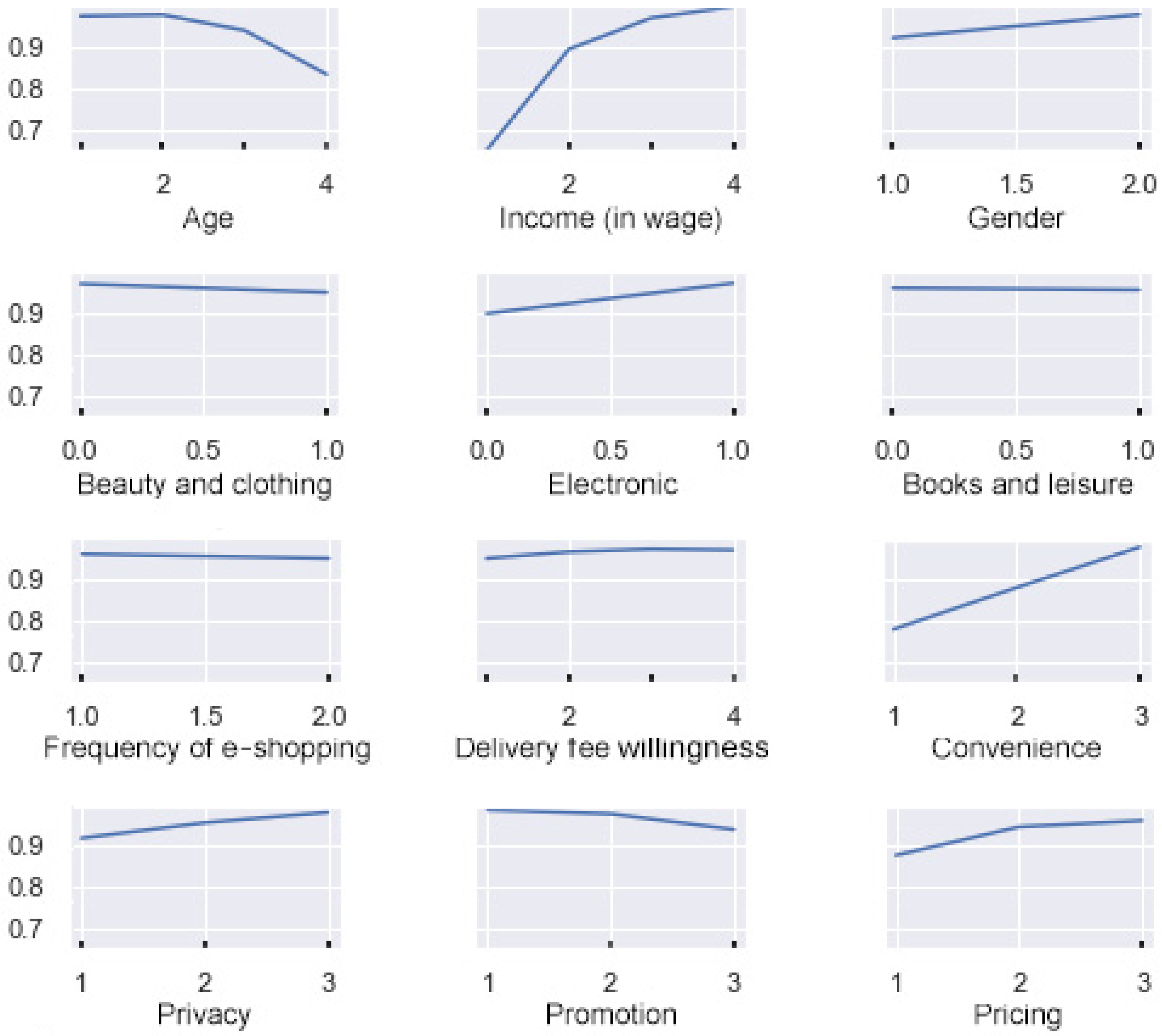

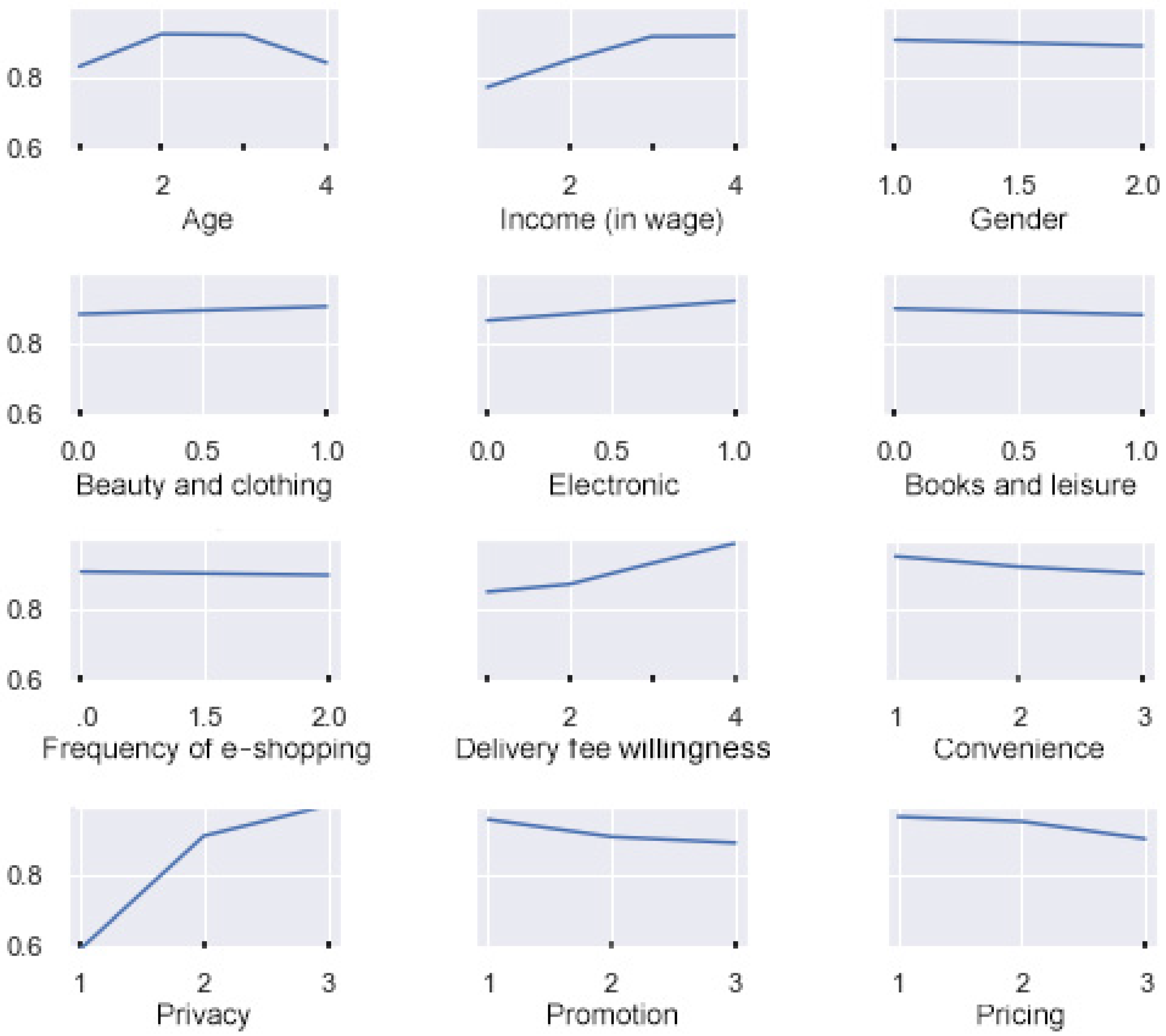

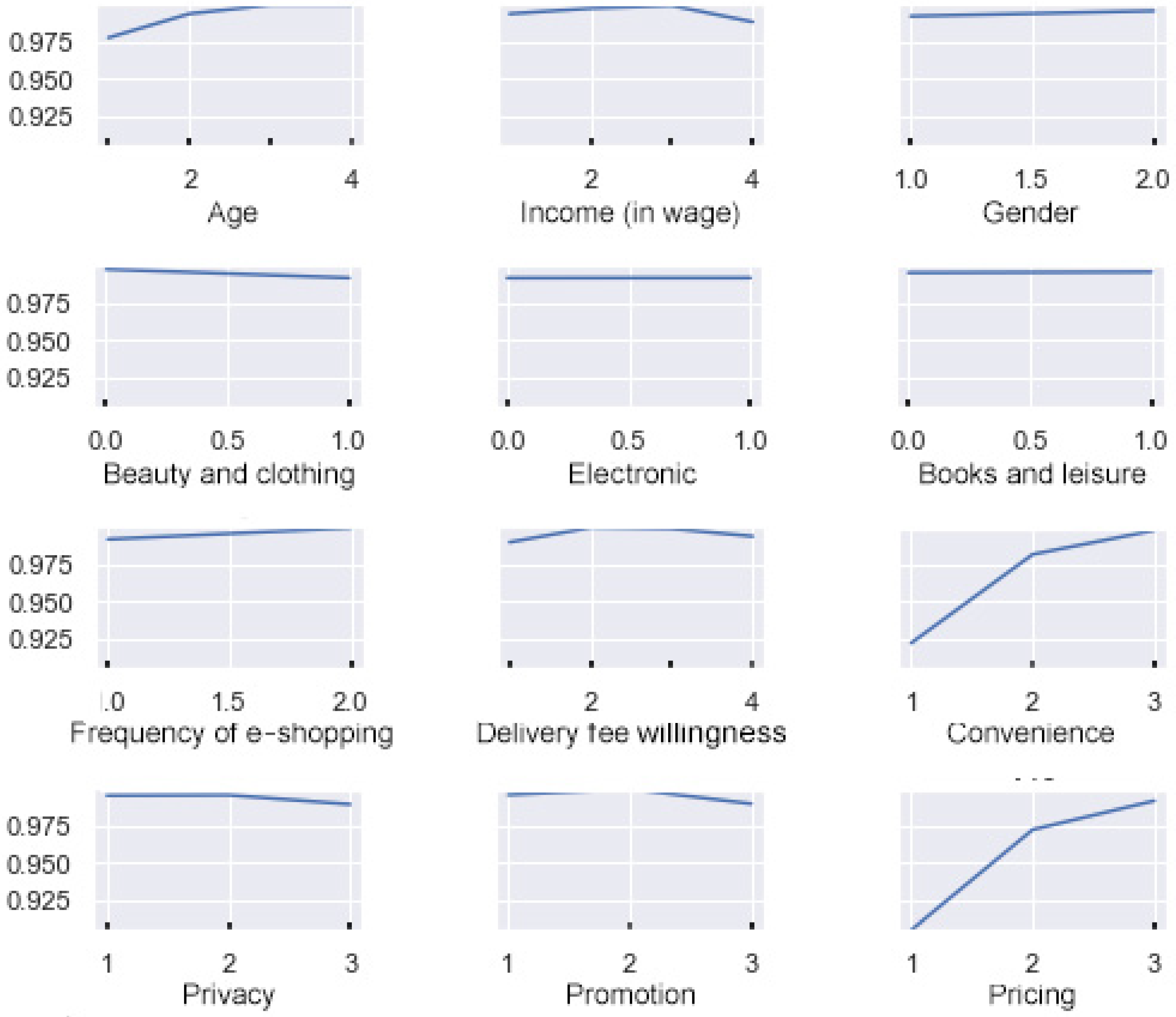

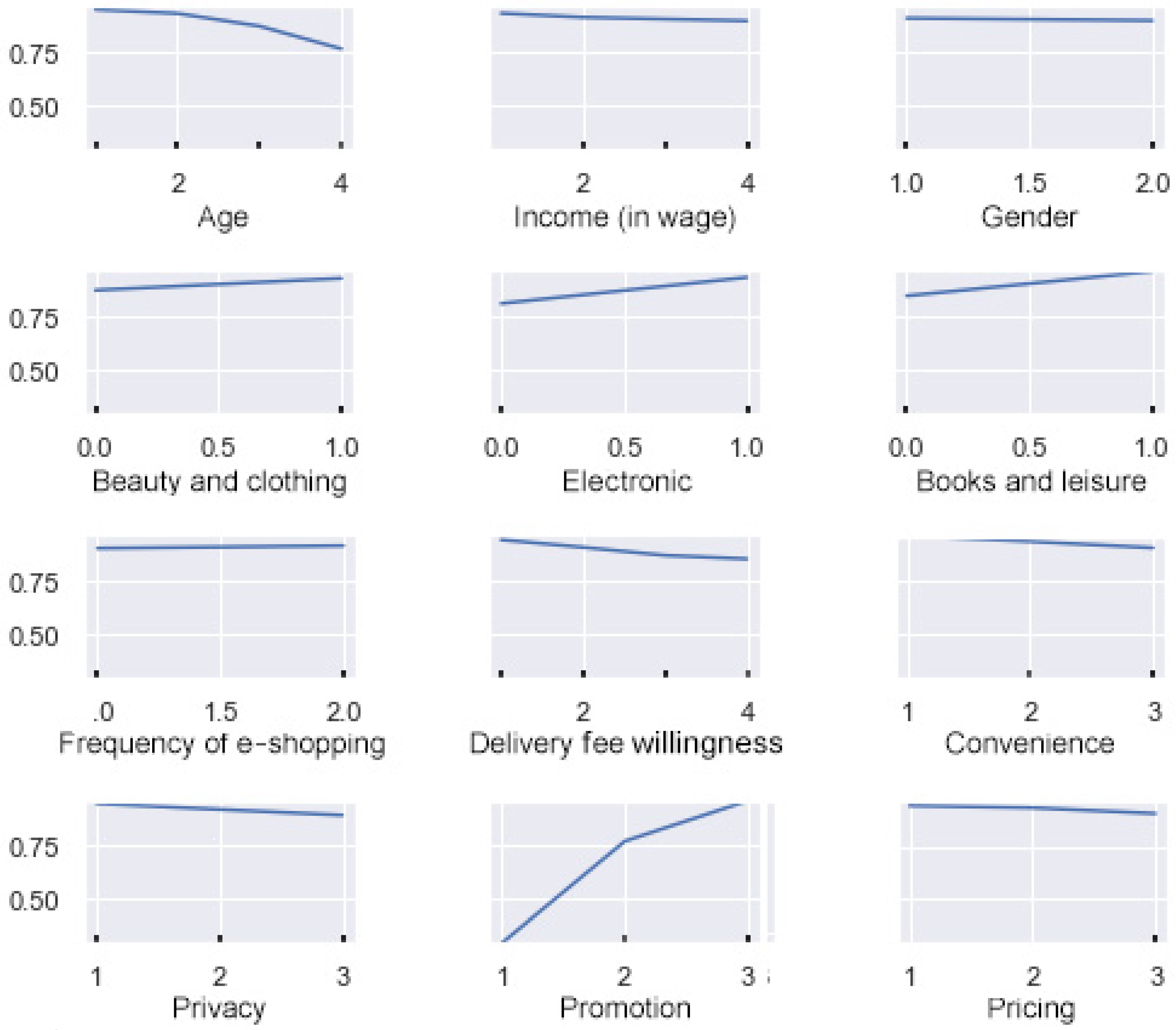

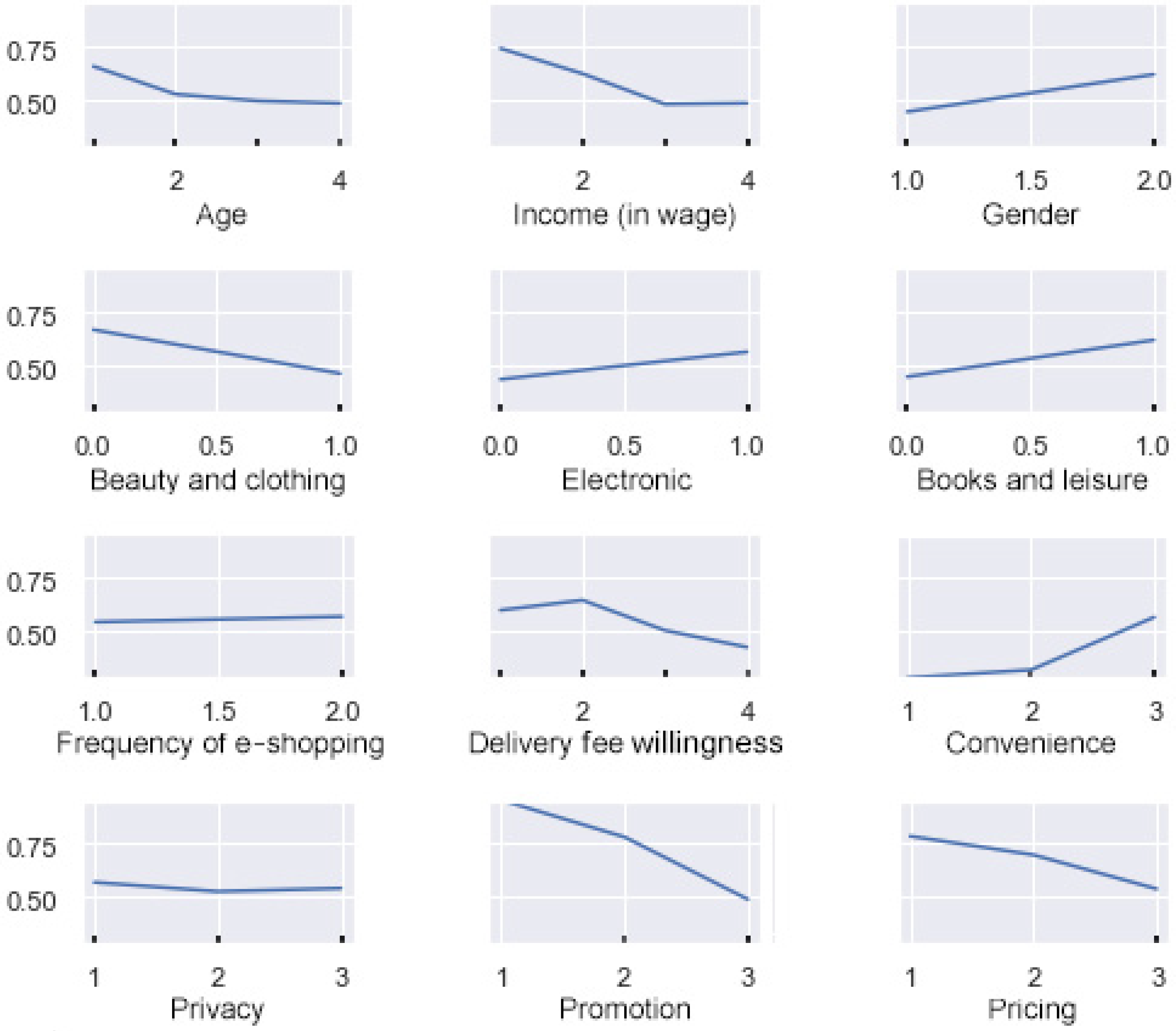

| Characteristics | Variables | Type of Response |
|---|---|---|
| Sociodemographic characteristics | Age | 15−24 years old |
| 25−34 years old | ||
| 35−49 years old | ||
| above 50 years old | ||
| Income (in minimum wages *) | less than one wage | |
| 2–4 wages | ||
| 4–10 wages | ||
| more than ten wages | ||
| Gender | male | |
| female | ||
| Consumption behaviour | Product type | beauty and clothing products |
| electronic products | ||
| books and leisure products | ||
| Frequency of e-shopping | once per month | |
| more than once per month | ||
| Delivery fee willingness to pay | until 3% of the product price | |
| until 7% of the product price | ||
| until 10% of the product price | ||
| over than 10% of the product price | ||
| E-shopping characteristics | Convenience | 5-Likert scale |
| Privacy | 3-Likert scale | |
| Promotion | 3-Likert scale | |
| Pricing | 3-Likert scale | |
| Delivery attributes | Importance of delivery time | 3-Likert scale |
| Importance of delivery fee | 3-Likert scale | |
| Importance of delivery reception | 3-Likert scale | |
| Influence of delivery fee | 3-Likert scale | |
| Influence of delivery reception | 3-Likert scale |
| Delivery Attribute | Accuracy of Neutral-Positive Conversion | Accuracy of Neutral-Negative Conversion |
|---|---|---|
| Importance of delivery time | 82% | 54% |
| Importance of delivery fee | 84% | 70% |
| Importance of delivery reception | 64% | 50% |
| Influence of delivery fee | 88% | 70% |
| Influence of delivery reception | 60% | 57% |
| Characteristics | Variables | Type of Response | Frequency | Percentage |
|---|---|---|---|---|
| Sociodemographic characteristics | Age | 15−24 years old | 123 | 21% |
| 25−34 years old | 275 | 46% | ||
| 35−49 years old | 121 | 20% | ||
| above 50 years old | 76 | 13% | ||
| Income | less than one wage | 9 | 2% | |
| 2–4 wages | 137 | 23% | ||
| 4–10 wages | 235 | 39% | ||
| more than ten wages | 214 | 36% | ||
| Gender | male | 318 | 53% | |
| female | 277 | 47% | ||
| Consumption behaviour | Product type | beauty and clothing products | 374 | 32% |
| electronic products | 459 | 40% | ||
| books and leisure products | 322 | 28% | ||
| Frequency of e-shopping | once per month | 410 | 69% | |
| more than once per month | 185 | 31% | ||
| Delivery fee willingness to pay | until 3% of the product price | 96 | 16% | |
| until 7% of the product price | 133 | 22% | ||
| until 10% of the product price | 262 | 44% | ||
| over than 10% of the product price | 104 | 17% |
| Title 2 | Description | Cronbach Alpha | Min | 1st Quartile | Median | 3rd Quartile | Max |
|---|---|---|---|---|---|---|---|
| E-shopping characteristics | Convenience | 0.783 | 1 | 3 | 3 | 3 | 3 |
| Privacy | 0.777 | 1 | 2 | 3 | 3 | 3 | |
| Promotion | 0.778 | 1 | 3 | 3 | 3 | 3 | |
| Pricing | 0.780 | 1 | 3 | 3 | 3 | 3 | |
| Delivery attributes | Importance of delivery time | 0.767 | 1 | 2 | 3 | 3 | 3 |
| Importance of delivery fee | 0.777 | 1 | 3 | 3 | 3 | 3 | |
| Importance of delivery reception | 0.770 | 1 | 2 | 2 | 3 | 3 | |
| Influence of delivery fee | 0.799 | 1 | 3 | 3 | 3 | 3 | |
| Influence of delivery reception | 0.790 | 1 | 1 | 2 | 3 | 3 |
| Variables | Range | Importance of Delivery Time | Importance of Delivery Fee | Importance of Delivery Reception | Influence of Delivery Fee | Influence of Delivery Reception | |
|---|---|---|---|---|---|---|---|
| Intercept | −3.21 *** | −2.24 | −2.00 ** | 18.72 | 2.06 ’ | ||
| Sociodemographic characteristics | Age | 25−34 years | −0.48 | −0.63 | −0.18 | −1.14 | −0.13 |
| 35−49 years | −0.09 | 0.36 | 0.65’ | −2.87 ** | −0.26 | ||
| >50 years | −0.64 | −0.57 | −0.09 | −3.21 ** | 0.726 ’ | ||
| Income | 2–4 wages | 0.61 | −1.58 | 0.48* | 1.23 | −0.11 | |
| 4–10 wages | 0.87 | −0.69 | 0.76 | 1.27 | −0.36 | ||
| >10 wages | 0.64 | −1.50 | 0.88 | 0.86 | 0.36 | ||
| Gender | Female | 0.92 ** | 0.89 ’ | 0.54 ** | 0.04 | 0.05 | |
| E-consumption behaviour | Product type | Beauty and clothing | −0.27 | −0.24 | 0.11 | −0.07 | −0.22 |
| Electronic products | −0.73 | −0.42 | −0.31 | 1.92 * | −0.13 | ||
| Books and leisure products | 0.26 | 1.03 * | −0.48 * | 0.05 | −0.03 | ||
| E-shopping frequency | > than once by month | −0.18 | 0.36 | −0.48 * | 0.41 | −0.27 | |
| Delivery fee willingness to pay | Until 7% | −0.69 | 0.27 | −0.29 | −0.09 | 0.24 | |
| Until 10% | −0.70 | −0.24 | −0.15 | −0.48 | 0.43 | ||
| >10% | −1.07 * | −0.88 | 0.07 | −0.29 | 0.61 * | ||
| E-shopping characteristics | Convenience | Neutral | 0.19 | 0.27 | 0.10 | 1.39 | 0.60 |
| Important | 0.52 | −0.24 | −0.33 | 0.55 | 0.40 | ||
| Privacy | Neutral | 0.55 | −0.55 | 1.19 *** | 0.52 | 0.10 | |
| Important | 1.42 ** | 1.21 ** | 1.28 * | 0.33 | 0.67 ** | ||
| Promotion | Neutral | 1.97 | 18.11 | −0.28 | −2.39 ** | −0.39 | |
| Important | 0.65 | 1.65 ** | 0.20 | −1.06 | −0.24 | ||
| Pricing | Neutral | 19.51 | 21.32 | 2.59 ** | −15.97 | −1.72 | |
| Important | 4.37 * | 5.13 * | 2.09 ** | −15.62 | −1.54 | ||
| Accuracy | 91% | 94% | 73% | 93% | 73% | ||
| Variables | Importance of Delivery Time | Importance of Delivery Fee | Importance of Delivery Reception | Influence of Delivery Fee | Influence of Delivery Reception | |
|---|---|---|---|---|---|---|
| Sociodemographic characteristics | Age | Medium (−) | Complex (concave) | Low (+) | Medium (−) | Medium (−) |
| Income | High (+) | Medium (+) | Low (−) | Low (−) | Medium (−) | |
| Gender | Low (+) | Constant | Low (–) | Constant | Medium (+) | |
| E-consumption behaviour | Beauty and clothing products | Low (−) | Constant | Low (−) | Low (+) | Medium (−) |
| Electronic products | Low (+) | Low (+) | Constant | Low (+) | Low (+) | |
| Books and leisure products | Constant | Constant | Constant | Low (+) | Low (+) | |
| Frequency of e–shopping | Constant | Constant | Low (+) | Constant | Constant | |
| Delivery fee willingness to pay | Low (+) | Medium (+) | Low (+) | Low (−) | Medium (−) | |
| E-shopping characteristics | Convenience | Medium (+) | Low (−) | High (+) | Low (−) | High (+) |
| Privacy | Low (+) | High (+) | Low (−) | Low (−) | Low (−) | |
| Promotion | Low (−) | Low (−) | Low (−) | High (+) | High (−) | |
| Pricing | Low (+) | Low (−) | High (+) | Low (−) | Medium (−) | |
| Delivery Attribute | Accuracy Logistic Regression | Accuracy ANN |
|---|---|---|
| Importance of delivery time | 91% | 82% |
| Importance of delivery fee | 94% | 84% |
| Importance of delivery reception | 73% | 64% |
| Influence of delivery fee | 93% | 88% |
| Influence of delivery reception | 73% | 60% |
Publisher’s Note: MDPI stays neutral with regard to jurisdictional claims in published maps and institutional affiliations. |
© 2021 by the authors. Licensee MDPI, Basel, Switzerland. This article is an open access article distributed under the terms and conditions of the Creative Commons Attribution (CC BY) license (https://creativecommons.org/licenses/by/4.0/).
Share and Cite
Dias, E.G.; Oliveira, L.K.d.; Isler, C.A. Assessing the Effects of Delivery Attributes on E-Shopping Consumer Behaviour. Sustainability 2022, 14, 13. https://doi.org/10.3390/su14010013
Dias EG, Oliveira LKd, Isler CA. Assessing the Effects of Delivery Attributes on E-Shopping Consumer Behaviour. Sustainability. 2022; 14(1):13. https://doi.org/10.3390/su14010013
Chicago/Turabian StyleDias, Emília Guerra, Leise Kelli de Oliveira, and Cassiano Augusto Isler. 2022. "Assessing the Effects of Delivery Attributes on E-Shopping Consumer Behaviour" Sustainability 14, no. 1: 13. https://doi.org/10.3390/su14010013
APA StyleDias, E. G., Oliveira, L. K. d., & Isler, C. A. (2022). Assessing the Effects of Delivery Attributes on E-Shopping Consumer Behaviour. Sustainability, 14(1), 13. https://doi.org/10.3390/su14010013








